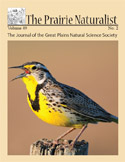Great Plains Natural Science Society

The Prairie Naturalist
Date of this Version
6-2016
Document Type
Article
Citation
The Prairie Naturalist 47:30–39; 2016
Abstract
Choice of sampling design is fundamental when planning surveys to monitor fisheries resources. However, little is known about the impact that different sampling designs may have on commonly collected fish population metrics used to index relative abundance, size structure, and diversity in small (<200 ha) glacial lakes. To address this issue, we sampled three small glacial lakes in eastern South Dakota with modified fyke nets and gill nets at fixed sites used by South Dakota Game, Fish and Parks and a complement of nets at randomized sites. Catch per unit effort (CPUE), proportional size distribution (PSD), and PSD-preferred (PSD-P) were compared between fixed and random designs for each species and gear by lake while Bray-Curtis distances were calculated between sample designs for each gear type in each lake. Precision of CPUE estimates for routinely indexed species were calculated for both gears used by each sampling design. No consistent bias in calculated population metrics was detected between sampling designs for any species collected with either gear type in the three lakes. Sampling precision of CPUE estimates were low for both gears and study designs; though randomized sites tended to yield lower precision. Power analyses indicated that current levels of sampling effort are insufficient to detect differences in CPUE or PSD/PSD-P between fixed and random sampling designs. In addition to being small, study lakes had relatively homogenous habitat allowing for effective sampling resulting in similar values of CPUE and PSD/PSD-P for both fixed and random study designs, and high assemblage overlap. We conclude that fixed sampling sites provide adequate representation of fish communities in small glacial lakes and are sufficient for monitoring temporal changes in these small, but numerous, systems.
Included in
Biodiversity Commons, Botany Commons, Ecology and Evolutionary Biology Commons, Natural Resources and Conservation Commons, Systems Biology Commons, Weed Science Commons


Comments
Published by the Great Plains Natural Science Society. Used by permission.